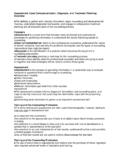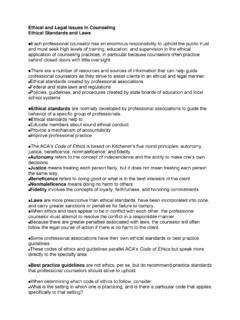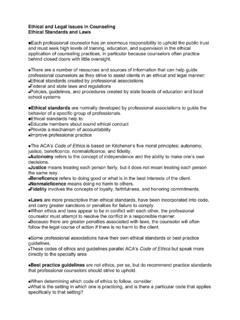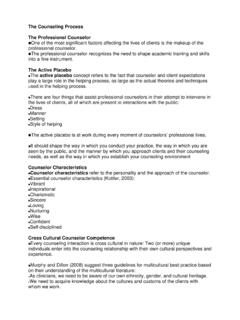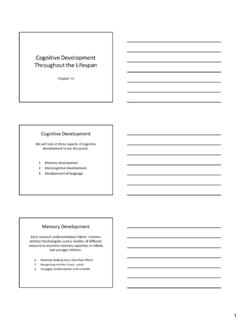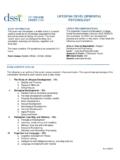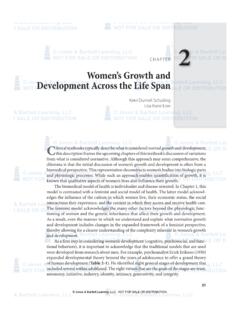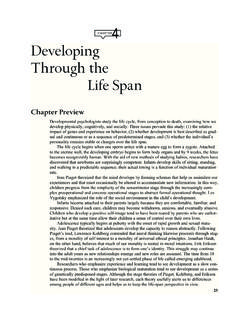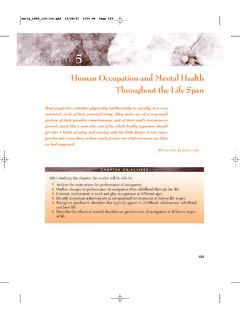Transcription of Human Development through the Life Span The …
1 Human Development through the life span The life span Perspective life is a journey, with each developmental stage posing a new set of challenges and opportunities. As professional counselors, we are in the unique position of not only experiencing our own growth and Development , but also facilitating our clients journey. The life - span perspective not only includes the belief that Development is lifelong, but also that it is multidimensional, multidisciplinary and contextual, multidirectional, and plastic. The life span Perspective life span developmental theory provides an organizational framework for understanding how the different stages of life are linked together and how the three adaptive processes of growth, maintenance, and regulation of loss are part of the developmental journey from infancy through old age.
2 Erikson s Stages of Psychosocial Development Basic trust versus mistrust Birth to 1 year Infants gain trust from a warm, responsive environment, in contrast to mistrust if they are mistreated or ignored Autonomy versus shame and doubt 1-3 years Autonomy is nurtured when children can use their skills to make their own decisions Initiative versus guilt 3-6 years Children experiment with who they can become through imaginative play If parents don t support their ambition and experimentation and expect too much self-control, the child may feel guilty Industry versus inferiority 6-11 years As they become more involved in school, children develop the ability to work with others If they have negative experiences with peers or in the home or school setting, they may experience feelings of inferiority Identity versus role confusion Adolescence Developing an identity is a key issue during this stage of Development , but can result in a negative outcome if there is confusion about future adult roles Intimacy versus isolation Young adulthood Establishing intimate ties with others is a major task at this stage Those who are unable to do this remain isolated Generativity versus stagnation Middle adulthood Giving to the next generation is the essence of this stage, and individuals who fail to do this feel stagnated without this meaningful sense of accomplishment Ego integrity versus despair Old age During this time of self-reflection, people who have lived satisfying lives develop a feeling of integrity.
3 While those who perceive they have not lived a satisfying life experience dissatisfaction and fear death Infancy and Toddlerhood The first 24 months of life constitute infancy, when major changes in all areas of Development occur at an astonishing pace. During toddlerhood (ages 2-3 years), remarkable changes, particularly in locomotion and language Development , significantly contribute to the young child s growing autonomy. Motor Development 3-4 months: Infants begin to roll over. 6 months: Infants can typically sit without support. 7-8 months: Infants can crawl and stand without support. 13 months: Infants can generally walk without assistance. There can be as much as a four month variation as to when these milestones occur, but the sequence of the accomplishments typically does not vary.
4 Toddlers not only master the previously mentioned skills, but between ages 2 and 3 years, locomotion is a key factor: Leg muscles are stronger They are walking and running Toddlers can jump several inches from the floor They appear to be in constant motion and enjoy what their bodies can do Fine motor skills, which are almost non-existent at birth, include reaching and grasping. 3 months of age: Infants have more control over their head and shoulders, which increases their ability to reach and grasp. 6-12 months: Infants can focus on small objects and reach out to grasp them. 12-18 months: Infants can scribble and turn pages of a book. During toddlerhood, these fine motor skills continue to develop: They begin to build high block towers and put puzzles together Their drawings advance: Whereas an 18-month-old can scribble, these scribbles start to become pictures and they use lines to represent boundaries of objects by age three years Emotional Development 3 months: Infants can smile and display rage or anger when they experience physical discomfort.
5 6-12 months: Infants are more aware of situations and their joy, anger, and fear are related to their environment. 6 months: Stranger anxiety emerges 9 months: Separation anxiety emerges 1 year: Infants not only display elation, but also anxiety, fear, and anger. 2 years: Toddlers begin to respond to others emotions and can show love by giving hugs and kisses. Cognitive/Language Development Piaget s cognitive-developmental theory contributes in part to our knowledge about cognitive Development . Piaget s theory is based on the premise that children discover or construct their knowledge through their own activity and that they move through four stages of Development . The sensorimotor stage (birth to 2 years) is divided into six substages with a progression of Development that results in some degree of mental representation.
6 During the preoperational stage (ages 2-7 years) mental representation increases dramatically, along with make believe play. With regard to language Development , infants cry and coo, then begin to babble. 10-15 months: Infants typically speak their first words, with rapid progression after that. 18 months: Infants have a 50 word vocabulary. 2 years: Toddlers have a 200 word vocabulary. 3 years: Toddlers typically have a vocabulary of 1000 words and their communication is generally well understood. Early Childhood Curiosity, questioning, and new socialization experiences through exposure to preschool and kindergarten characterize this stage of early childhood Development . Social Development Play serves an important role for children, both in their own skill Development and also in relation to others.
7 Associative play, where children interact and share but do not actually seem to be playing the same game, characterizes 4-year-olds By age five years, children engage in more cooperative play, take turns, and create games Children at this age prefer same-gender playmates, not only in the United States, but also in other cultures. Boys tend to be more involved in rough and tumble play and are more aggressive. Girls are more inclined to engage in nurturing activities and are more cooperative. Emotional Development Children are not only able to talk about their feelings, but they can also incorporate feelings into pretend play, which gives them a better understanding of their feelings and how to express them in acceptable ways. Because children often lack the ability to accurately verbalize their feelings, they tend to express them directly through action.
8 Cognitive Development Preoperational thought patterns characterize the cognitive Development of 4-, 5-, and 6-year-olds. Because children are able to represent objects and events mentally, they can think and act more flexibly than during the sensorimotor stage. However, children at this age have: Egocentrism: The inability to see things from another perspective Centration: The tendency to focus on one aspect of a situation rather than on a broader view By age five years, children can understand almost anything explained to them in context if the examples are specific, but they may have difficulty with concepts such as time and space. Imaginative play and vivid fantasies characterize this period of Development , particularly for preschoolers. Middle Childhood Rich years filled with growth and change is how Cobb (2001, p.)
9 448) characterized middle childhood. Although their physical rate of growth has stabilized, 6-11 year-olds mature remarkably during these school-age years. Socialization in the context of a peer group becomes a central issue for the middle-aged child. Acceptance in a group and a best friend contribute significantly to a child s sense of competence Friendships serve important functions: Children learn to cooperate and compromise, negotiate, and assume roles as leaders and followers. They also learn how to deal with peer group pressure and rejection. School-aged children s understanding of emotions is more complex than preschoolers and in general they are more sensitive, empathic, and better able to recognize and communicate their feelings to others. Fears and anxieties are related to real- life , as opposed to imaginary issues.
10 A transitional period between preoperational and concrete operational thought occurs between the ages of five and seven years, but by age seven or eight years, the vast majority of children are definitely concrete operational thinkers. Concrete operational thinkers are able to understand logical operations, such as identity, reversibility, reciprocity, and classification and can apply them in different contexts, such as friendships, rules in games, or team play Adolescence The relative stability of middle childhood can vanish over night as children enter puberty, thus signifying the beginning of early adolescence (ages 11-14 years), which is followed by mid adolescence (ages 15-18 years), and later adolescence (ages 18-24 years), oftentimes referred to as the beginning of young adulthood.
